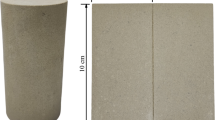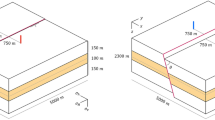Abstract
A fault can be both the inrush channel and the water source. In order to better understand how such a mine disaster develops, a fluid–solid coupling analysis model and a Forchheimer, nonlinear, non-Darcian flow model were used to study an inrush in the Hongcai coal mine. Numerical simulation was used to reconstruct the dynamic process of the inrush. Then the coupled evolution of the stress, displacement, and seepage fields were analyzed and the precursor information characteristics were summarized. The results showed that the inrush was the result of excavation disturbance and hydraulic pressure in the fault fracture zone. Before the inrush occurs, the stress of the surrounding rock drops after continually increasing, the displacement of the surrounding rock increases sharply after a stable build-up, and the gradually increasing pore water pressure of the surrounding rock decreases rapidly just before the inrush. During this process, the multi-field information in the aquiclude continuously changes. During the inrush, groundwater flows into the roadway from top to bottom along the fault fracture zone. The pressure in the runoff path continuously decreases and the flow velocity generally increases. However, when the water initially enters the channel and roadway, the flow velocity first decreases due to the change in flow direction, and then increases again, and the velocity and pressure gradually stabilizes after the water finally enters the roadway. These results help explain how flooding caused by a water-rich fault inrush evolves and provide a scientific basis for determining the characteristics of appropriate inrush precursors.
Zusammenfassung
Eine Verwerfung kann sowohl Wasserquelle als auch Leitungsbahn für einen Wassereinbruch sein. Um besser zu verstehen, wie sich ein solches Minenunglück entwickelt, wurden ein gekoppeltes Fluid-Feststoff-Analyse modell und ein nicht Darcy-basiertes, nichtlineares Forchheimer Strömungsmodell verwendet, um einen Wassereinbruch in der Kohlenmine von Hongcai zu untersuchen. Numerische Simulation wurde verwendet, um den dynamischen Prozess des Wassereinbruchs zu rekonstruieren. Dann wurde die gekoppelte Entwicklung der Spannungs-, Verschiebungs- und Durchsickerungsfelder analysiert und es wurden die Charakteristika von Vorbotenanzeichen zusammengestellt. Die Ergebnisse zeigen, dass der Wassereinbruch das Ergebnis von Betriebsstörung bei der Abgrabung und hydraulischem Druck in der Verwerfungszone war. Unmittelbar vor dem Wassereinbruch nimmt die Spannung des umgebenden Gesteins nach fortschreitender Zunahme ab, die Verschiebung des angrenzenden Gesteins vergrößert sich nach stabiler Aufbauphase schlagartig und der allmählich ansteigende Porenwasserdruck des umgebenden Gesteins nimmt kurz vor dem Einbruch rasch ab. Während dieses Vorgangs ändert sich die Multi-Feld-Information im Grundwasserstauer ständig. Beim Wassereinbruch strömt das Grundwasser entlang der Bruchzone von oben nach unten in die Vortriebsstrecke ein. Der Druck in der Abflussbahn nimmt kontinuierlich ab und üblicherweise erhöht sich die Strömungsgeschwindigkeit. Jedoch zu Beginn, wenn das Wasser in den Kanal und die Vortriebsstrecke eintritt, nimmt die Strömungsgeschwindigkeit wegen Änderung der Strömungs¬richtung zuerst ab und steigt dann wieder an. Nachdem das Wasser schließlich in die Vortriebsstrecke gelangt ist, stabilisieren sich die Geschwindigkeit und der Druck allmählich. Diese Ergebnisse helfen zu erklären, wie Überschwemmungen durch den Einbruch einer wasser-reichen Verwerfung entstehen und liefern eine wissenschaftliche Grund-lage für die Bestimmung der Charakteristika geeigneter Vorboten von Wassereinbrüchen.
Resumen
Una falla puede ser tanto el canal de entrada como la fuente de agua. Para comprender mejor cómo se desarrolla el desastre de una mina, se utilizó un modelo de análisis de acoplamiento fluido-sólido y un modelo de flujo Forchheimer, no lineal, no-Darciano para estudiar una irrupción en la mina de carbón de Hongcai. La simulación numérica fue utilizada para reconstruir el proceso dinámico de la irrupción. Luego se analizó la evolución acoplada de la tensión, del desplazamiento y de los campos de infiltración y se resumieron las características de información precursora. Los resultados mostraron que la irrupción fue el resultado de la perturbación de la excavación y la presión hidráulica en la zona de fractura de falla. Antes de que ocurra la avalancha, la tensión de la roca circundante disminuye después de aumentar continuamente, el desplazamiento de la roca circundante aumenta bruscamente después de de cierta estabilidad y la gradualmente creciente presión de agua de poro de la roca circundante disminuye rápidamente justo antes de la irrupción. Durante este proceso, la información multicampo en el acuicludo cambia continuamente. Durante la irrupción, el agua subterránea fluye en la carretera desde arriba a abajo a lo largo de la zona de la falla. La presión en la trayectoria de la corriente disminuye continuamente y la velocidad del flujo generalmente aumenta. Sin embargo, cuando el agua ingresa inicialmente al canal y a la carretera, la velocidad del flujo primero disminuye debido al cambio en la dirección del flujo y luego aumenta nuevamente, y la velocidad y la presión se estabilizan gradualmente después de que el agua finalmente ingresa a la carretera. Estos resultados ayudan a explicar cómo evoluciona la inundación causada por una avalancha de falla rica en agua y proporcionan una base científica para determinar las características de los apropiados precursores de irrupción.
断层既可作突水通道又可能为突水水源。为更好地理解断层突水发展过程,采用流固耦合模型和福希海默、非线性、非达西流模型研究了红彩煤矿突水案例。首先,用数值模型重塑突水过程;然后,分析了应力场、位移场和渗流场的耦合演化,总结了突水前兆特征。结果表明,突水是由巷道开挖对断层破碎带的扰动作用和水压作用引起。在突水发生之前,围岩应力由持续增长转为减小,围岩位移由稳定增大突变为急剧增长,围岩孔隙水压力由逐渐增长转向迅速减小。在这一过程中,弱透水层内的多场信息也持续变化。突水时,地下水沿断层从顶到底涌入大巷,径流带压力持续减小而流速缓慢增大。然而,当涌水进入巷道时,流速首先因为方向改变而减小,然后才恢复和增大;突水最终流进入巷道后,速度和压力逐趋稳定。研究结果有助于解释富水断层突水灾变过程,能够为突水预警提供理论依据。













Similar content being viewed by others
References
Bense VF, Berg EHVD, Balen RTV (2003) Deformation mechanisms and hydraulic properties of fault zones in unconsolidated sediments; the Roer Valley rift system, The Netherlands. Hydrogeol J 11(3):319–332
Bu WK, Mao XB (2009) Research on effect of fault dip on fault activation and water inrush of coal floor. Chin J Rock Mech Eng 21(2):119–123
Elsworth D, Bai M (1992) Flow-deformation response of dual-porosity media. J Geotech Eng 118(1):107–124
Li LJ, Qian MG, Li SG (1996) Mechanism of water-inrush through fault. J Chin Coal Soc 21(2):119–123 (in Chinese)
Li B, Wu Q, Duan XQ, Chen MY (2018) Risk analysis model of water inrush through the seam floor based on set pair analysis. Mine Water Environ 37(4):281–287
Ma D, Bai HB, Miao XX, Pu H, Jiang BY, Chen ZQ (2016) Compaction and seepage properties of crushed limestone particle mixture: an experimental investigation for Ordovician karst collapse pillar groundwater inrush. Environ Earth Sci 75(1):1–14
Nelson EP, Kullman AJ, Gardner MH, Batzle M (1999) Fault-fracture networks and related fluid flow and sealing, Brushy Canyon formation, west Texas. In: Haneberg WC, Mozley PS, Moore JC, Goodwin LB (eds) Faults and Subsurface Fluid Flow in the Shallow Crust, 113. AGU, Washington, pp 69–81
Peng SP, Meng ZP, Wang H, Ma CL, Pan JN (2003) Experimental study on pore ratio and permeability of sandstone under different confining pressures. Chin J Rock Mech Eng 22(5):742–746 (in Chinese)
Pradipkumar GN, Venkataraman P (1995) Non-darcy converging flow through coarse granular media. J Inst Eng (India) 76:6–11
Pu H, Zang J (2010) Numerical simulation of water inrush from coal roof affected by fault. J Min Saf Eng 27(3):421–424 (in Chinese)
Qian MG, Shi PW (2003) Mining pressure and strata control. Univ of Mining and Technology of China Press, Xuzhou (in Chinese)
Rutqvist J, Tsang CF (2002) A study of caprock hydromechanical changes associated with CO2-injection into a brine formation. Environ Geol 42:296–305
Santos CF, Bieniawski ZT (1967) Floor design in underground coalmines. Rock Mech Rock Eng 22(4):249–271
Shi WH, Yang TH, Liu HL, Yang B, Yang X, Zhou YF (2016) Non-darcy flow model and numerical simulation for water-inrush in fractured rock mass. Chin J Rock Mech Eng 35(3):446–455 (in Chinese)
Wu Q (2014) Progress, problems and prospects of prevention and control technology of mine water and reutilization in China. J Chin Coal Soc 39(5):795–805 (in Chinese)
Wu Q, Zhu B, Li JM, Hong YQ, Qian ZJ (2008) Numerical simulation of lagging water-inrush mechanism of rock road ways near fault zone. J China Univ Min Technol 37(6):421–424 (in Chinese)
Wu Q, Li B, Chen YL (2016) Vulnerability assessment of groundwater inrush from underlying aquifers based on variable weight model and its application. Water Resour Manag 30(10):3331–3345
Zhang JC, Zhang YZ, Liu TQ (1997) Rock mass permeability and coal mine water inrush. Geological Publ Press, Beijing (in Chinese)
Acknowledgements
This research was financially supported by the China National Natural Science Foundation (Grants 41702270, 41572222, and 41702261), Guizhou University Introducing Talents Research Foundation (2014-61), Guizhou Province Science and Technology Planning Project (Qian Ke He Platform Talent [2017]5788), Guizhou Provincial Education Dept. Youth Science, and the Technology Talent Growth Project (Qian Jiao He KY Zi [2018]113), Guizhou Provincial Basic Research Program Key Project (Qian Ke He Ji Chu [2019]1413).
Author information
Authors and Affiliations
Corresponding author
Rights and permissions
About this article
Cite this article
Li, B., Wu, Q. Catastrophic Evolution of Water Inrush from A Water-Rich Fault in Front of Roadway Development: A Case Study of The Hongcai Coal Mine. Mine Water Environ 38, 421–430 (2019). https://doi.org/10.1007/s10230-018-00584-z
Received:
Accepted:
Published:
Issue Date:
DOI: https://doi.org/10.1007/s10230-018-00584-z




